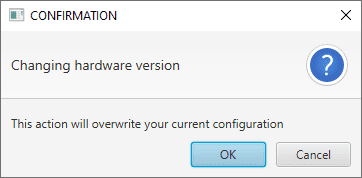Configuration¶
This section explains each option and parameter available in 1x PDI Builder.
Once the installation is finished, open 1x PDI Builder and select the unit.
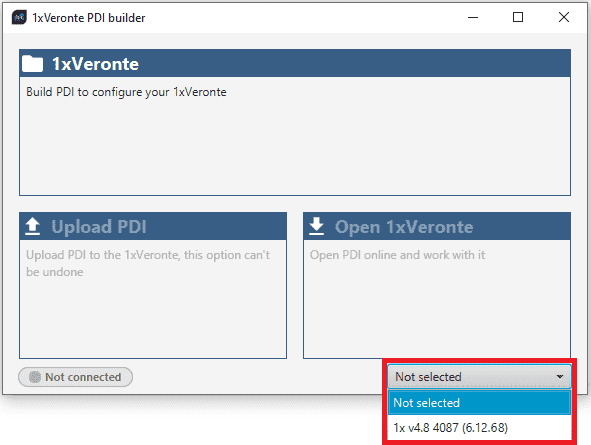
Autopilot 1x ID¶
If it is correctly connected, 1x PDI Builder will display the mode in which the connected unit is. In addition, a PDI error button ![]() will appear:
will appear:
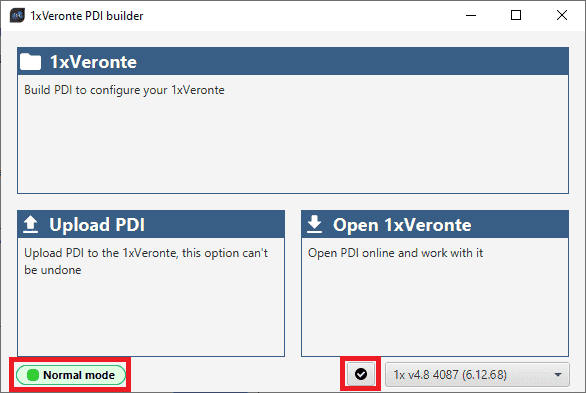
1x PDI Builder¶
1x mode: 1x unit should appear in Normal mode, as shown in the figure above, or Maintenance mode.
It can also appear as Maintenance mode (loaded with errors) or Normal mode - Disconnected.
Note
Maintenance mode (loaded with errors) appears when something is wrong in the configuration. For more information, see Maintenance mode (loaded with errors) - Troubleshooting section of this manual.
 PDI Errors button: The user can check if the connected unit has PDI Errors by simply clicking on it. If there are no errors, the following message appears:
PDI Errors button: The user can check if the connected unit has PDI Errors by simply clicking on it. If there are no errors, the following message appears: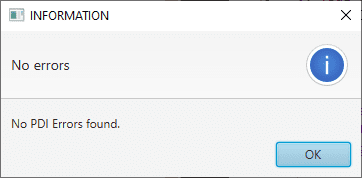
1x PDI Builder - PDI Errors message¶
The user can access now to 3 configuration options:
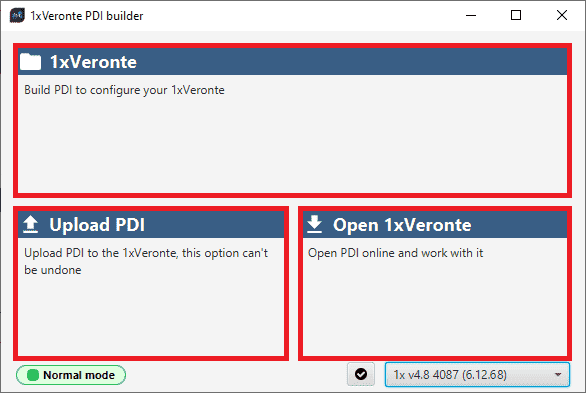
1x PDI Builder options¶
1xVeronte: It allows the user to work with offline configurations. A previously exported 1x PDI configuration can be opened and modified or it is possible to build a new one from the default configuration.
Upload PDI: A previously exported 1x PDI configuration can be imported to the linked 1x.
This option is also intended to upload to Autopilot 1x a calibration previously exported with the 1x PDI Calibration software.
Warning
When a configuration is loaded into Veronte Autopilot 1x with a version older than the software version being used, an automatic migration from the configuration version to the software version being used will be performed.
For more information on this, see Migrate configuration - Troubleshooting section of this manual.
Open 1xVeronte: By clicking on this option, 1x PDI Builder configuration menu opens with the configuration (the PDI files) loaded in the connected 1x. Then, the user can modify it online.
Note
PDI files are 1x configuration files. These files allow for modular control with improved version management. These PDI files are split in 2 folders. Each folder hold several .xml files:
operation: This folder holds all the files related with the operations defined, such as waypoints, routes, operative parameters, runways, etc.
setup: This contains the configuration of the vehicle. All the control loops and their parameters, the definition of the flight phases and guidance commands, and the automations defined are stored here.
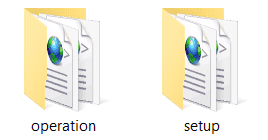
PDIs files¶
Finally, click on ‘1xVeronte’ to edit a configuration offline or ‘Open 1xVeronte’ to open the current configuration and start editing it online. The different ‘buttons’ that can be seen in the initial menu of the 1x PDI Builder are explained below.
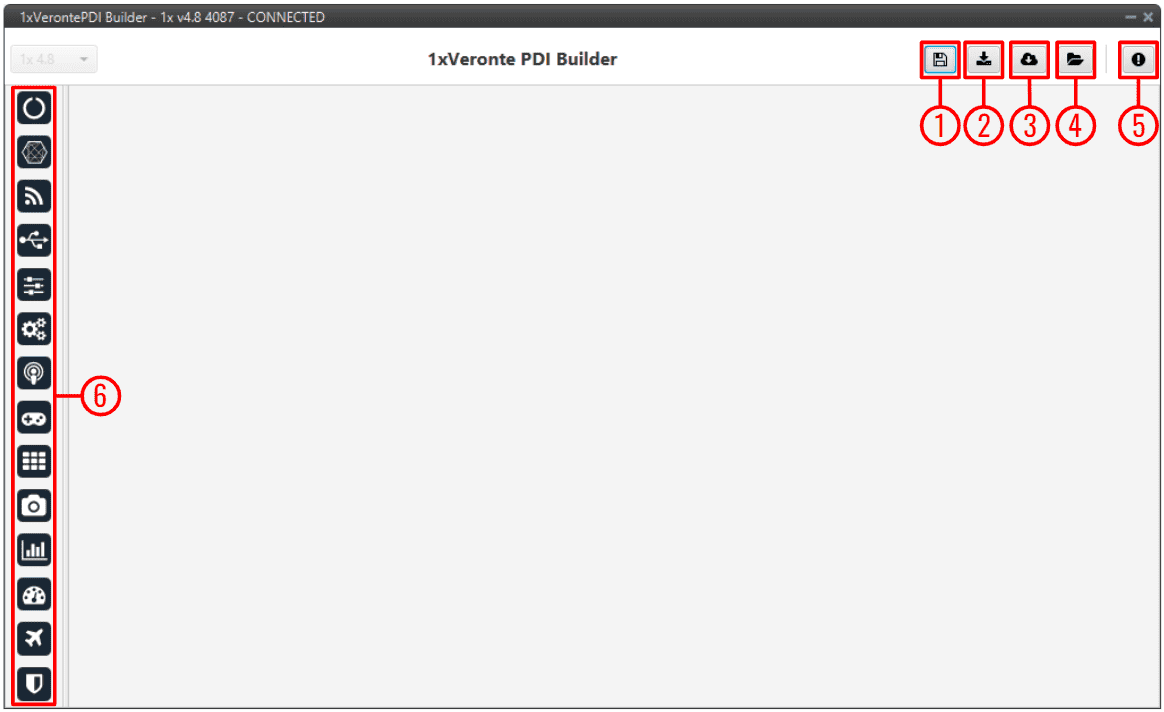
Initial menu¶
Save and close: After changes are done, press on the save button to apply the changes.
While saving, a percentage of saving process is displayed:
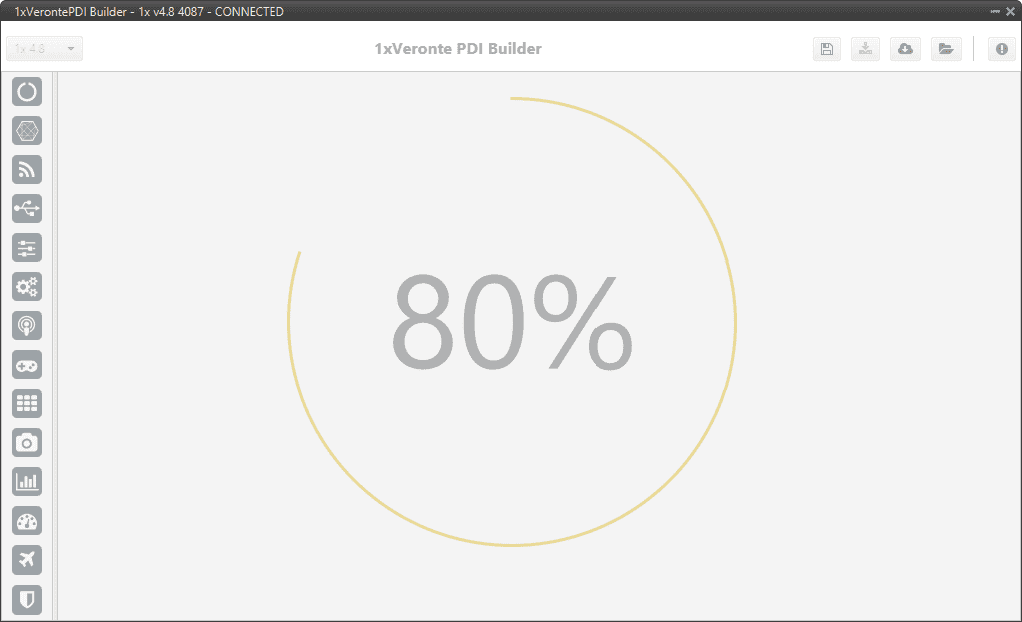
Save and close¶
In order to save the configuration, Veronte Autopilot 1x must enter in maintenance mode. Then, after saving any changes, Autopilot 1x will RESET and 1x PDI Builder software will consequently close. Therefore, users must accept the following confirmation panels for this to be possible:
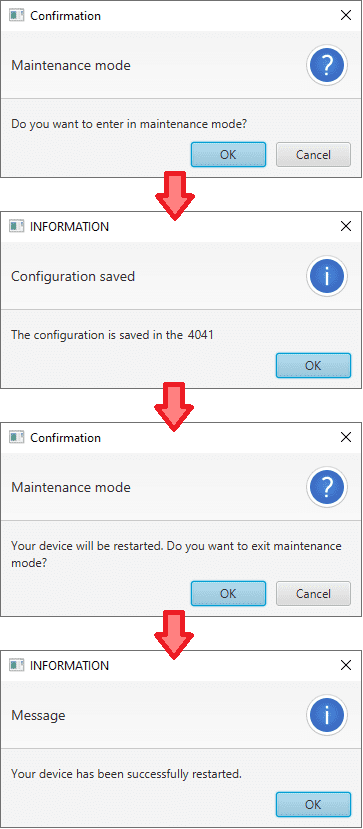
Save and close - Confirmation panels¶
Danger
As Veronte Autopilot 1x is reset, it is not advisable to save changes during flight tests.
Note
This button will only appear if an Autopilot 1x is connected, i.e. when working offline this button will not be available.
Export PDI: After modifying a configuration, press the Export button to store the configuration in the local storage. Users can store this configuration in an empty folder or in the folder where the previously imported configuration is stored. With the latter option, the “original” configuration will be overwritten by the one with the new changes.
The user can choose between:
Download PDI: With this option the 2 folders with the PDI files are downloaded.
Download VER file: Download a .ver file with the configuration in binary. This option is only available ‘online’, otherwise it will be disabled.

Download option¶
Import PDI from repo: The user can import a configuration file from the GitHub repository and modify it. After that, if the Save and close button (1) is pressed, this configuration will be uploaded on the 1x.
Import PDI from local storage: The user can import a configuration file from the local storage and modify it. After that, if the Save and close button (1) is pressed, this configuration will be loaded into the 1x.
Warning
If users want to upload a configuration in this way (either from the repo or from local storage), note that only the configuration ‘setup’ folder is uploaded, the ‘operation’ folder is not.
This means that the operation of the new configuration uploaded to the Autopilot 1x will not be saved, but the previous operation will remain.
Feedback: Users can report a problem they have encountered by creating an issue in their own ‘Joint Collaboration Framework’. The ‘Download’ button downloads a zipped folder with the current 1x configuration and more information needed for Embention to resolve the issue. It is advisable to attach this folder when creating the issue.
Note
The user’s ‘Joint Collaboration Framework’ is simply a own Github repository for each customer.
If the user has any questions about this Joint Collaboration Framework, please see Joint Collaboration Framework user manual or contact sales@embention.com.

Feedback¶
These are the different functions of Autopilot 1x. Each option will be explained in detail in the next sections.
Icon
Item
Description
Introduce Autopilot 1x information
Configure I/O connections on Autopilot 1x
Configure parameter sensors
Configure external sensors/devices and I/O signals
Introduce Phases, Modes and Arcade axis configuration
Configure automatic actions on event detection (go home, change phase…)
Configure alternative communication channels, statistics and routing
Cusomize transmitter configuration
Customize algorithms executed by Autopilot 1x
Configure connected devices such as transponder/ADS-B, camera…
Customize traffic such as log, telemetry…
Customize variable names
Configure parameters for hardware in the loop simulations
Customize checklist, block user control in PDI configuration and safety bits


